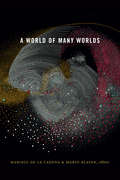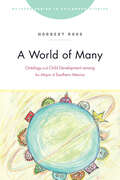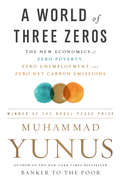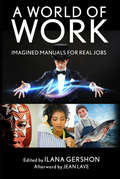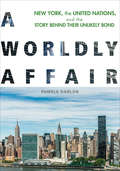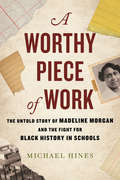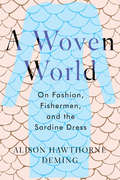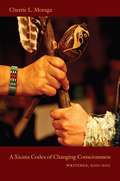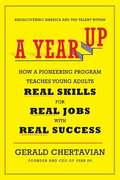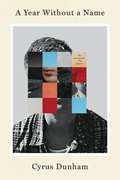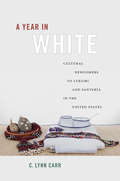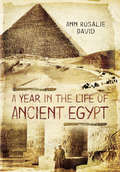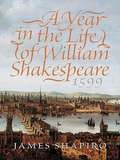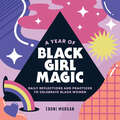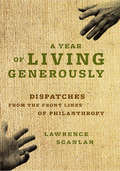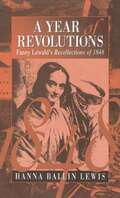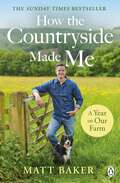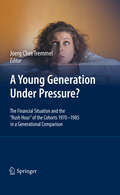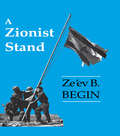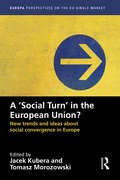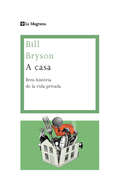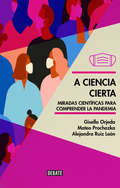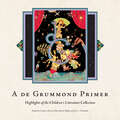- Table View
- List View
A World of Many Worlds
by Mario Blaser Marisol de la CadenaA World of Many Worlds is a search into the possibilities that may emerge from conversations between indigenous collectives and the study of science's philosophical production. The contributors explore how divergent knowledges and practices make worlds. They work with difference and sameness, recursion, divergence, political ontology, cosmopolitics, and relations, using them as concepts, methods, and analytics to open up possibilities for a pluriverse: a cosmos composed through divergent political practices that do not need to become the same. Contributors. Mario Blaser, Alberto Corsín Jiménez, Déborah Danowski, Marisol de la Cadena, John Law, Marianne Lien, Isabelle Stengers, Marilyn Strathern, Helen Verran, Eduardo Viveiros de Castro
A World of Many: Ontology and Child Development among the Maya of Southern Mexico (Rutgers Series in Childhood Studies)
by Norbert RossA World of Many explores the world-making efforts of Tzotzil Maya children from two different localities within the municipality of Chenalhó, Chiapas. The research demonstrates children’s agency in creating their worlds, while also investigating the role played by the surrounding social and physical environment. Different experiences with schooling, parenting, goals and values, but also with climate change, water scarcity, as well as racism and settler colonialism form part of the reason children create their emerging worlds. These worlds are not make believe or anything less than the ontological products of their parents. Instead, Norbert Ross argues that by creating different worlds, the children ultimately fashion themselves into different human beings - quite literally being different in the world. A World of Many combines experimental research from the cognitive sciences with critical theory, exploring children’s agency in devising their own ontologies. Rather than treating children as somewhat incomplete humans, it understands children as tinkerers and thinkers, makers of their worlds amidst complex relations. It regards being as a constant ontological production, where life and living constitutes activism. Using experimental paradigms, the book shows that children locate themselves differently in these emerging worlds they create, becoming different human beings in the process.
A World of Three Zeros: The New Economics Of Zero Poverty, Zero Unemployment, And Zero Carbon Emissions
by Muhammad YunusA winner of the Nobel Peace Prize and bestselling author of Banker to the Poor offers his vision of an emerging new economic system that can save humankind and the planet Muhammad Yunus, who created microcredit, invented social business, and earned a Nobel Peace Prize for his work in alleviating poverty, is one of today's most trenchant social critics. Now he declares it's time to admit that the capitalist engine is broken--that in its current form it inevitably leads to rampant inequality, massive unemployment, and environmental destruction. We need a new economic system that unleashes altruism as a creative force just as powerful as self-interest. Is this a pipe dream? Not at all. In the last decade, thousands of people and organizations have already embraced Yunus's vision of a new form of capitalism, launching innovative social businesses designed to serve human needs rather than accumulate wealth. They are bringing solar energy to millions of homes in Bangladesh; turning thousands of unemployed young people into entrepreneurs through equity investments; financing female-owned businesses in cities across the United States; bringing mobility, shelter, and other services to the rural poor in France; and creating a global support network to help young entrepreneurs launch their start-ups. In A World of Three Zeros, Yunus describes the new civilization emerging from the economic experiments his work has helped to inspire. He explains how global companies like McCain, Renault, Essilor, and Danone got involved with this new economic model through their own social action groups, describes the ingenious new financial tools now funding social businesses, and sketches the legal and regulatory changes needed to jumpstart the next wave of socially driven innovations. And he invites young people, business and political leaders, and ordinary citizens to join the movement and help create the better world we all dream of.
A World of Work: Imagined Manuals for Real Jobs
by Jean Lave Ilana GershonEver wondered what it would be like to be a street magician in Paris? A fish farmer in Norway? A costume designer in Bollywood? This playful and accessible look at different types of work around the world delivers a wealth of information and advice about a wide array of jobs and professions. The value of this book is twofold: For young people or middle-aged people who are undecided about their career paths and feel constrained in their choices, A World of Work offers an expansive vision. For ethnographers, this book offers an excellent example of using the practical details of everyday life to shed light on larger structural issues.Each chapter in this collection of ethnographic fiction could be considered a job manual. Yet not any typical job manual--to do justice to the ways details about jobs are conveyed in culturally specific ways, the authors adopt a range of voices and perspectives. One chapter is written as though it was a letter from an older sister counseling her brother on how to be a doctor in Malawi. Another is framed as a eulogy for a well-loved village magistrate in Papua New Guinea who may have been killed by sorcery.Beneath the novelty of the examples are some serious messages that Ilana Gershon highlights in her introduction. These ethnographies reveal the connection between work and culture, the impact of societal values on the conditions of employment. Readers will be surprised at how much they can learn about an entire culture by being given the chance to understand just one occupation. Contributors: Lovleen Bains, Mumbai; Chiwoza Bandawe, University of Malawi; Joshua A. Bell, Smithsonian Institution; Michelle Bigenho, Colgate University; Warren Chamberlain, Vita Needle Company, Massachusetts; Melissa Demian, Australian National University; Ilana Gershon, Indiana University; Kathryn Graber, Indiana University; Graham M. Jones, MIT; Amanda Kemble, The George Washington University; Briel Kobak, The George Washington University; Corinna Kruse, Linköping University, Sweden; Joel Kuipers, The George Washington University; Carrie Lane, California State University, Fullerton; Jean Lave, University of California, Berkeley; John Law, Open University; Heather Levi, Temple University; Marianne Elisabeth Lien, University of Oslo; Caitrin Lynch, Olin College; Loïc Marquet, Paris; Winnifred Fallers Sullivan, Indiana University; Chris Swift, Leeds Teaching Hospitals; Claire Wendland, University of Wisconsin-Madison; Clare Wilkinson, University of Pennsylvania; Helena Wulff, Stockholm University
A Worldly Affair: New York, the United Nations, and the Story Behind Their Unlikely Bond
by Pamela HanlonFor more than seven decades, New York City and the United Nations have shared the island of Manhattan, living and working together in a bond that has been likened to a long marriage—both tempestuous and supportive, quarrelsome and committed. A Worldly Affair tells the story of this hot and cold romance, from the 1940s when Mayor Fiorello La Guardia was doggedly determined to bring the new world body to New York, to the UN’s flat rejection of the city’s offer, then its abrupt change of course in the face of a Rockefeller gift, and on to some tense, troubling decades that followed. Racial prejudice and anti-Communist passions challenged the young international institution. Spies, scofflaw diplomats, provocative foreign visitors, and controversial UN-member policy positions tested New Yorkers’ patience. And all the while, the UN’s growth—from its original 51 member states to 193 by 2017—placed demands on the surrounding metropolis for everything from more office space, to more security, to better housing and schools for the international community’s children. As the city worked to accommodate the world body’s needs—often in the face of competition from other locales vying to host at least parts of the UN entity—New Yorkers at times grew to resent its encroachment on their neighborhoods, and at times even its very presence. It was a constituent sentiment that provoked more than one New York mayor to be less than hospitable in dealing with the city’s international guests. Yet, as the UN moves into its eighth decade in New York—with its headquarters complex freshly renovated and the city proudly proclaiming that the organization adds nearly $4 billion to the New York economy each year—it seems clear the decades-old marriage will last. Whatever the inevitable spats and clashes along the way, the worldly affair is here to stay.
A Worthy Piece of Work: The Untold Story of Madeline Morgan and the Fight for Black History in Schools
by Michael HinesThe story of Madeline Morgan, the activist educator who brought Black history to one of the nation&’s largest and most segregated school systemsA Worthy Piece of Work tells the story of Madeline Morgan (later Madeline Stratton Morris), a teacher and an activist in WWII-era Chicago, who fought her own battle on the home front, authoring curricula that bolstered Black claims for recognition and equal citizenship.During the Second World War, as Black Americans both fought to save democracy abroad and demanded full citizenship at home, Morgan&’s work gained national attention and widespread praise, and became a model for teachers, schools, districts, and cities across the country. Scholar Michael Hines unveils this history for the first time, providing a rich understanding of the ways in which Black educators have created counternarratives to challenge the anti-Black racism found in school textbooks and curricula.At a moment when Black history is under attack in school districts and state legislatures across the country, A Worthy Piece of Work reminds us that struggles over history, representation, and race are far from a new phenomenon.
A Woven World: On Fashion, Fishermen, and the Sardine Dress
by Alison Hawthorne DemingPart memoir, part cultural history, A Woven World celebrates the fading crafts, industries, and artisans that have defined communities for generations.The desire to create is the cornerstone of civilization. But as we move into a world where machine manufacturing has nearly usurped craft, Alison Hawthorne Deming resists the erasure of our shared history of handiwork with this appeal for embracing continuity and belonging in a time of destabilizing change.Sensing a need to preserve the crafts and stories of our founding communities, and inspired by an exhibit at the Metropolitan Museum of Art&’s Costume Institute featuring Yves St. Laurent&’s &“sardine&” dress, Deming turned to the industries of her ancestors, both the dressmakers and designers in Manhattan in the nineteenth century and the fishermen on Grand Manan Island, a community of 2,500 residents, where the dignity of work and the bounty of the sea ruled for hundreds of years. Reweaving the fabric of those lives, A Woven World gives presence on the page to the people, places, and practices, uncovering and preserving a record of the ingenuity and dignity that comes with such work. In this way the lament becomes a song of praise and a testament to the beauty and fragility of human making.
A Xicana Codex of Changing Consciousness: Writings, 2000-2010
by Cherríe L. MoragaA Xicana Codex of Changing Consciousness features essays and poems by CherrÍe L. Moraga, one of the most influential figures in Chicana/o, feminist, queer, and indigenous activism and scholarship. Combining moving personal stories with trenchant political and cultural critique, the writer, activist, teacher, dramatist, mother, daughter,comadre, and lesbian lover looks back on the first ten years of the twenty-first century. She considers decade-defining public events such as 9/11 and the campaign and election of Barack Obama, and she explores socioeconomic, cultural, and political phenomena closer to home, sharing her fears about raising her son amid increasing urban violence and the many forms of dehumanization faced by young men of color. Moraga describes her deepening grief as she loses her mother to Alzheimer's; pays poignant tribute to friends who passed away, including the sculptor Marsha GÓmez and the poets Alfred Arteaga, Pat Parker, and Audre Lorde; and offers a heartfelt essay about her personal and political relationship with Gloria AnzaldÚa. Thirty years after the publication of AnzaldÚa and Moraga's collection This Bridge Called My Back, a landmark of women-of-color feminism, Moraga's literary and political praxis remains motivated by and intertwined with indigenous spirituality and her identity as Chicana lesbian. Yet aspects of her thinking have changed over time. A Xicana Codex of Changing Consciousness reveals key transformations in Moraga's thought; the breadth, rigor, and philosophical depth of her work; her views on contemporary debates about citizenship, immigration, and gay marria>= and her deepening involvement in transnational feminist and indigenous activism. It is a major statement from one of our most important public intellectuals.
A Year Up: How a Pioneering Program Teaches Young Adults Real Skills for Real Jobs -- with Real Success
by Gerald ChertavianThe inspiring story of a pioneering program that is redefining urban young adults as economic assets, not deficits. During Gerald Chertavian's many years as a Big Brother, the former technology entrepreneur realized that our nation's "Opportunity Divide" strands millions of young, disadvantaged, yet motivated workers at the bottom of the job ladder. In 2000, Chertavian dedicated his life to closing that divide and Year Up was born. A Year Up is an intensive program that offers low income young adults training, mentorship, internships, and ultimately real jobs--often with Fortune 500 companies. 85 percent of program graduates are employed or in full-time college within four months of graduation. Today, A Year Up serves more than 1,300 students in nine cities across the nation. Following A Year Up class from admissions through graduation, A Year Up lets students share--in their own words--the challenges, failures, and personal successes they've experienced during their program year. This deeply moving and inspirational story also explains Chertavian's philosophy and the program's genesis, offering a road map for real change in our country and a beacon for young adults who want the opportunity to enter the economic mainstream.
A Year Without a Name: A Memoir
by Cyrus Grace DunhamFrom "an extraordinary new voice," a "passionate and clear-eyed and unputdownable" meditation on queerness, family, and desire. (Mary Karr)For as long as they can remember, Cyrus Grace Dunham felt like a visitor in their own body. Their life was a series of imitations--lovable little girl, daughter, sister, young gay woman--until their profound sense of alienation became intolerable.Moving between Grace and Cyrus, Dunham brings us inside the chrysalis of gender transition, asking us to bear witness to an uncertain and exhilarating process that troubles our most basic assumptions about who we are and how we are constituted. Written with disarming emotional intensity in a voice uniquely theirs, A Year Without a Name is a potent, thrillingly unresolved queer coming of age story. Named one of Fall 2019's Most Anticipated Books by:TimeNYLONVogueELLEBuzzfeed BustleO Magazine
A Year by the Sea: Thoughts of an Unfinished Woman (Core Ser.)
by Joan AndersonNow available in paperback, the entrancing story of how one woman's journey of self-discovery gave her the courage to persevere in re-creating her life.Life is a work in progress, as ever-changing as a sandy shoreline along the beach. During the years Joan Anderson was a loving wife and supportive mother, she had slowly and unconsciously replaced her own dreams with the needs of her family. With her sons grown, however, she realized that the family no longer centered on the home she provided, and her relationship with her husband had become stagnant. Like many women in her situation, Joan realized that she had neglected to nurture herself and, worse, to envision fulfilling goals for her future. As her husband received a wonderful job opportunity out-of-state, it seemed that the best part of her own life was finished. Shocking both of them, she refused to follow him to his new job and decided to retreat to a family cottage on Cape Cod.At first casting about for direction, Joan soon began to take plea-sure in her surroundings and call on resources she didn't realize she had. Over the course of a year, she gradually discovered that her life as an "unfinished woman" was full of possibilities. Out of that magical, difficult, transformative year came A Year by the Sea, a record of her experiences and a treasury of wisdom for readers.This year of self-discovery brought about extraordinary changes in the author's life. The steps that Joan took to revitalize herself and rediscover her potential have helped thousands of woman reveal and release untapped resources within themselves.From the Trade Paperback edition.
A Year in White
by C. Lynn CarrIn the Afro-Cuban Lukumi religious tradition--more commonly known in the United States as Santería--entrants into the priesthood undergo an extraordinary fifty-three-week initiation period. During this time, these novices--called iyawo--endure a host of prohibitions, including most notably wearing exclusively white clothing. In A Year in White, sociologist C. Lynn Carr, who underwent this initiation herself, opens a window on this remarkable year-long religious transformation. In her intimate investigation of the "year in white," Carr draws on fifty-two in-depth interviews with other participants, an online survey of nearly two hundred others, and almost a decade of her own ethnographic fieldwork, gathering stories that allow us to see how cultural newcomers and natives thought, felt, and acted with regard to their initiation. She documents how, during the iyawo year, the ritual slowly transforms the initiate's identity. For the first three months, for instance, the iyawo may not use a mirror, even to shave, and must eat all meals while seated on a mat on the floor using only a spoon and their own set of dishes. During the entire year, the iyawo loses their name and is simply addressed as "iyawo" by family and friends. Carr also shows that this year-long religious ritual--which is carried out even as the iyawo goes about daily life--offers new insight into religion in general, suggesting that the sacred is not separable from the profane and indeed that religion shares an ongoing dynamic relationship with the realities of everyday life. Religious expression happens at home, on the streets, at work and school. Offering insight not only into Santería but also into religion more generally, A Year in White makes an important contribution to our understanding of complex, dynamic religious landscapes in multicultural, pluralist societies and how they inhabit our daily lives.
A Year in the Life of Ancient Egypt: Pdf
by Ann Rosalie DavidAn overview of daily life in ancient Egypt, its society, and culture.Based on years of prestigious academic work, Professor Rosalie David cleverly presents every aspect of life in ancient Egypt through the lives of various characters, all based on mummies from the Manchester Museum whom Professor Rosalie David has led the study of. Characters hail from all walks of life, including royalty, nobles, officials, craftsmen and peasants, allowing us an insight into absolutely every aspect of everyday, ritual and religious life in ancient Egypt.The book provides an overview of the many dynasties and kingdoms of ancient Egypt before beginning to tell the story of the lives of one family. All three seasons of inundation, planting and growing, and harvesting are covered as well as all ritual and religious events, including birth and death. The book is extremely easy to read and digest, however, the attention to detail and the vivid picture of life which we are able to build makes it clear that this book has been written by one of the leading authorities in Egyptology and mummy research.
A Year in the Life of William Shakespeare
by James S. ShapiroThose with a keen interest in Shakespeare will enjoy insight into the man, his work and his times. Shapiro knows his readership will be a motivated one and is counting on the subject material to drive them to carry on. What makes the book an engaging read is the political context it provides. We begin to understand why he wrote some of his plays and certain characters, and what pressures he would've dealt with keeping his craft "cutting-edge", but popular to the masses, as well as staying in the Queen's favor.
A Year of Black Girl Magic: Daily Reflections and Practices to Celebrate Black Women (A Year of Daily Reflections)
by Eboni MorganCelebrate the magic of being a Black woman with 365 days of inspiration As a Black woman, you carry innate magic inside of you everywhere you go—and no one can take that away from you. This book is full of practices and reflections to help you recognize your power and cherish your strength and beauty. Through a year's worth of daily self-reflection, you'll learn to embrace who you are, love yourself unconditionally, and nurture your entire being. Explore monthly themes—Navigate your journey toward greater self-love with relevant themes for each month, including new beginnings, self-care, being present, sisterhood, facing your fears, and setting boundaries. Discover a variety of exercises—Reignite the fire within you through simple activities, thought-provoking reflections, positive affirmations, and words of wisdom from other Black women. Use evidence-based techniques—Empower yourself in every area of life using proven methods like mindfulness, meditation, visualizations, positive psychology, and cognitive behavioral therapy. Honor your Black girl magic every day of the year with this book to guide and inspire you.
A Year of Living Generously
by Lawrence ScanlanA Year of Living Generously follows award-winning journalist Lawrence Scanlan as he volunteers with 12 different charities, among them well-known institutions Habitat for Humanity, the St. Vincent de Paul Society and Canadian Crossroads.Drawing from first-hand experiences - serving in a soup kitchen in Ontario, building houses in post-Katrina New Orleans and teaching at a women's radio station in Senegal - Scanlan tests the ideas and theories on global aid and philanthropy and makes a compelling case for greater commitment and real connection from us all. The result is an engaging yet informative primer for today's volunteers, young and old, who are looking to make a meaningful contribution.
A Year of Revolutions: Fanny Lewald's Recollections of 1848 (Berghahn Series)
by Hanna Ballin LewisLewald (1811-1889), the best-selling German woman writer in the nineteenth century, proved a keen and perceptive observer of the social, artistic, and political life of her times, of which these Recollections offer an excellent example. Written from a woman's perspective, this first-hand account of the revolutions in both Germany and France must be considered a unique document. It is further enhanced by her detailed description of the Frankfurt Parliament and her relationships with many of the prominent politicians and thinkers of that eventful period. Hanna Ballin Lewis has written extensively on Fanny Lewald and is Professor in the Department of Foreign Languages at Sam Houston Sate University.
A Year on Our Farm: How the Countryside Made Me
by Matt BakerEscape into nature with Matt Baker's fascinating journey through the natural year and family life on the farm'A delight' Countryfile Magazine_______Matt Baker finds his calm on the farm.Surrounded by nature with his family, dogs, array of sheep, Mediterranean miniature donkeys and a whole host of wildlife in the farm's ancient woodland, Matt shows us how the power and beauty of the countryside can bring joy to us all.Following the ever-changing seasons of the year, we see woodland animals emerge after a long winter of hibernation and lambs begin to gambol in April. We hear the dawn chorus in the height of summer and see the preparations unfold for the harsh and wild winter months.Peppered with hand drawn sketches, unforgettable moments from Matt's TV career and stories of a landscape you'll fall in love with - from its sun-soaked pastures to 6ft snow drifts - Matt reveals how the outdoors has made him who he is today.
A Young Generation Under Pressure?: The Financial Situation and the "Rush Hour" of the Cohorts 1970 - 1985 in a Generational Comparison
by Joerg TremmelJustice between generations is still not as prominent on any agenda as justice between rich and poor or men and women. For the first time, this three-part book explores the situation of young people of today in comparison to their direct predecessors. The first part, The Financial Situation of the Young Generation in a Generational Comparison, deals with this generation's financial standing; the second part, The Rush Hour of Life, examines their time restrictions. Both are considered from a life-course perspective. The third part, On the Path to Gerontocracy?, addresses the demographic shift in favor of the elderly in aging Western democracies.
A Zionist Stand
by Ze'ev B. BeginA member of the Knesset, Dr Begin here reflects upon the mainstream political thought of the Likud Party which came to power in 1977. This book analyzes the basic factors relevant to the Israeli position in the Middle East, providing a different outlook on the complexities of the region.
A `Social Turn’ in the European Union?: New trends and ideas about social convergence in Europe (Europa Perspectives on the EU Single Market)
by Jacek KuberaSocial Europe is a key topic in the construction of the EU and its institutions. This volume examines the current state of, and perspectives for, Social Europe, as well as key issues in European social policy, including the posting of workers, the impact of the free market and regulations on social convergence, work automation, digitalisation, taxation and democracy in the workplace. The aim of this volume is to identify a course to be followed in integrating the EU’s social policies and point to areas in which co-operation between member states is likely to produce best results. While a Social Europe was previously seen to be a natural consequence of political and economic integration, it is now viewed as a separate area that requires active policies to preserve the European project. The EU’s big question today concerns the level at which this policy should be pursued: the volume’s contributors outline difficulties with harmonising social policies across the Union, but they nevertheless argue that, owing to the common challenges faced by Europe, the idea of a Social Europe must not be abandoned and requires specific action. The volume consists of 11 chapters written by a variety of expert authors, analysing the idea of a Social Europe and proposing ways in which it could be put into practice. Social policy can no longer be seen as derived from economic policy but rather as a separate driver of development that could be of interest to the northern, southern and eastern states of the EU. Jacek Kubera, PhD, Assistant Professor, Faculty of Sociology, Adam Mickiewicz University in Poznań. Tomasz Morozowski, PhD candidate, Faculty of Political Science and Journalism, Adam Mickiewicz University in Poznań, and analyst at the Poznań Institute for Western Affairs.
A caballo entre milenios
by Fernando SavaterUn libro que admite múltiples lecturas: crónica deportiva, libro de viajes, relato de aventuras, reflexión sobre los gozos y las sombras en el cruce de dos siglos... Al hilo de la búsqueda apasionada de la carrera de caballos ideal, el autor recorre el mundo, desde Buenos Aires a Dubai, desde San Sebastián a Hong Kong y Tokio, sin olvidar los grandes hipódromos clásicos de Kentucky, Epsom o Longchamp. En esas travesías se cruza con la presencia y la memoria de los mejores caballos que han existido, con obras literarias y con películas, pero también con las preocupaciones de la actualidad política y social: el terrorismo, las drogas, la diversidad cultural, la democracia... Y siempre con las mil caras del amor a la vida y las mil amenazas de la muerte. Un diario singular del año dos mil para los lectores del siglo XXI.
A casa
by Bill BrysonDesprés d’haver recorregut desenes de països pels continents europeu, africà i americà, el controvertit autor de Breu història de gairebé tot emprèn un fascinants viatge... per l’interior de casa seva. Un dia, Bill Bryson va pensar que dediquem molt més temps a estudiar les batalles i les guerres de la història que a reflexionar sobre allò del que està feta la pròpia història: segles de gent dedicada a les tasques del dia a dia, menjant, dormint i tractant de viure amb més comoditats, i que la major part dels principals descobriments de la humanitat es troben en la mateixa estructura de casa nostra. D’aquesta manera, inicià un viatge per casa seva amb la ment oberta i la curiositat com a bandera, tot fent petites descobertes que expliquen qui som, d’on venim i quin ha estat el llarg recorregut que hem fet per viure com vivim. En aquesta petita història de la vida domèstica, Bill Bryson es pregunta quan i per què es va inventar la xemeneia, o bé per quin motiu a algú se li va acudir fer forquilles amb quatre puntes, i encara més: sabíeu que la llum que desprèn una nevera moderna és superior a la que podia il·luminar una casa fa tan sols dos cents anys? Bryson aplica la seva insaciable curiositat i enginy irresistible, i ofereix un dels llibres més entretinguts i esclaridors sobre la història de la nostra manera de viure. No us perdeu un sol detall del que s’explica en aquest llibre perquè no us deixarà de sorprendre tot el que desconeixem sobre el que tenim més a l’abast. Ressenya:«Si aquest llibre no us proporciona conversa per als sopars que celebreu durant els propers cinc anys, és que no hi heu posat prou atenció.»People
A ciencia cierta: Miradas científicas para comprender la pandemia
by Gisella Orjeda MATEO PROCHAZKA ALEJANDRA RUIZ LEÓNUn e-book que nos permite revalorar el papel de la ciencia y la investigación en tiempos de pandemia. A ciencia cierta. Miradas científicas para comprender la pandemia propone al lector una nueva valoración a la labor científica y médica para la humanidad en tiempos de crisis sanitarias. La pandemia del COVID-19 ha revelado el fundamental aporte de nuestros científicos y médicos peruanos para salvar vidas y profundizar en la investigación. Estos ensayos de Gisella Orjeda, expresidente de CONCYTEC; Mateo Prochazka, médico epidemiólogo y Alejandra Ruiz León, bioquímica y fundadora de Mitocondria Comunicación, exponen el rol trascendental que la ciencia tiene en nuestras vidas.
A de Grummond Primer: Highlights of the Children's Literature Collection
by Carolyn J. Brown, Ellen Hunter Ruffin, and Eric L. TribunellaContributions by Ann Mulloy Ashmore, Rudine Sims Bishop, Ruth B. Bottigheimer, Jennifer Brannock, Carolyn J. Brown, Ramona Caponegro, Lorinda Cohoon, Carol Edmonston, Paige Gray, Laura Hakala, Andrew Haley, Wm John Hare, Dee Jones, Allison G. Kaplan, Megan Norcia, Nathalie op de Beeck, Amy Pattee, Deborah Pope, Ellen Hunter Ruffin, Anita Silvey, Danielle Bishop Stoulig, Roger Sutton, Deborah D. Taylor, Eric L. Tribunella, Alexandra Valint, and Laura E. Wasowicz During the 1960s, a dedicated library science professor named Lena de Grummond initiated a letter-writing campaign to children’s authors and illustrators requesting original manuscripts and artwork to share with her students. Now named after de Grummond, this archive at the University of Southern Mississippi has grown into one of the largest collections of historical and contemporary youth literature in North America with original contributions from more than 1,400 authors and illustrators, as well as over 185,000 volumes. The first book-length project on the collection, A de Grummond Primer: Highlights of the Children's Literature Collection provides a history of de Grummond’s work and an introduction to major topics in the field of children’s literature. With more than ninety full-color images, it highlights particular strengths of the archive, including extensive holdings of fairy tales, series books, nineteenth-century periodicals, Golden Age illustrated books, Mississippi and southern children’s literature, nonfiction, African American children’s literature, contemporary children’s and young adult authors and illustrators, and more. The book includes contributions from literature and information science scholars, historians, librarians, and archivists—all noted experts on children’s literature—and points to the exciting research possibilities of the archive.De Grummond could not have realized when she wrote to luminaries like H. A. and Margret Rey, Berta and Elmer Hader, Madeleine L’Engle, J. R. R. Tolkien, Lois Lenski, Garth Williams, and others that their correspondence and contributions would form the foundation for this extraordinary trove now visited by scholars from around the world. Such major authors and illustrators as Ezra Jack Keats, Richard Peck, Rosemary Wells, Angela Johnson, and John Green continued to donate content. In addition, curators, past and present, have acquired both historical and contemporary volumes of literature and criticism.
